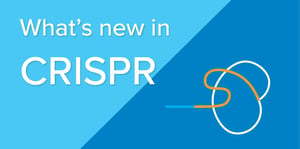 In this quarterly blog series, we’ll highlight a few of the new CRISPR plasmids available at Addgene. We will still periodically focus on specific CRISPR plasmid tools more in-depth, but we hope that this blog series will help you find new CRISPR tools for your research!
In this quarterly blog series, we’ll highlight a few of the new CRISPR plasmids available at Addgene. We will still periodically focus on specific CRISPR plasmid tools more in-depth, but we hope that this blog series will help you find new CRISPR tools for your research!
This time:
- E. coli genome-wide CRISPR inhibition
- Covalent tethering of DNA template to Cas9
- SECURE base editors
- Nme2Cas9
- CRISPR interference in Candida albicans
E. coli genome-wide inhibition library
To expand the tools available for genome-wide studies in E. coli, the Chong Zhang lab developed a genome-scale CRISPR inhibition pooled library (~60,000 gRNAs) that targets ~4,000 E. coli genes with ~15 gRNAs per gene and includes ~10,000 gRNAs targeting intergenic regions. The libraries also include 2,400 gRNAs without any significant hit across the E. coli genome as a negative control.
- Read the paper in Nature Communications
Covalent tethering of DNA repair template to Cas9
Homology-directed repair (HDR) can be used to make precise modification in genome editing. However, HDR efficiency is low. Wendy Gordon's lab developed a strategy to enhance HDR repair using a single-stranded oligodeoxynucleotide HDR template covalently attached to the Cas9-gRNA RNP complex via the fused HUH endonuclease PCV. This increases HDR efficiency up to 30-fold.
- Read the paper in Communications Biology
- Find the Cas9-PCV and PCV-Cas9 plasmids
Selective curbing of unwanted RNA editing (SECURE) base editors
Keith Joung’s lab recently found that a cytosine base editor (CBE) with rat APOBEC1 causes genome-wide deamination of RNA cytosines in human cells. Thus, they engineered two CBE variants with mutations in the rat APOBEC1 that decreases the number of off-target RNA edits by >390 fold and >3,800 fold in human cells with no significant reduction in editing efficiency.
- Read the paper in Nature
- Find the SECURE base editors
All-in-one AAV delivery of Nme2Cas9 with gRNA cassette
Erik Sontheimer’s lab identified a Cas9 protein from Neisseria meningitidis, Nme2Cas9, that recognizes a simple dinucleotide PAM (N4CC), lending to high target site density (average every 8 bp). Nme2Cas9 is also small enough that it can be packaged into AAV. The lab used single-AAV delivery of Nme2Cas9 and the sgRNA to demonstrate efficient editing in adult mice and in zygotes.
- Read the paper in Molecular Cell
- Find the Nme2Cas9 All-in-One AAV constructs
CRISPR interference in Candida albicans
A new CRISPR interference (CRIPSRi) platform for targeted gene repression in Candida albicans was developed by Rebecca Shapiro’s lab. After testing dCas9 fusions with transcriptional repressors, they found that fusing dCas9 to an Mxi1 repressor domain repressed transcription of HSP90 an essential C. albicans gene.
- Read the paper in mSphere
- Find the dCas9 and dCas9-Mxi1 plasmids
If you have a new CRISPR tool you’ve recently deposited to Addgene and you’d like it to be included in the next What’s New in CRISPR blog post, please let us know. We also welcome blog posts from guest bloggers. Check out this blog post for more information.
Additional resources on the Addgene blog
- Download the CRISPR 101 eBook
- Find our CRISPR 101 blog posts
- Read our CRISPR cheat sheet
Resources on Addgene.org
- Read our CRISPR guide
- Find CRISPR plasmids by function
- Find recently deposited plasmids
Topics: CRISPR, Other CRISPR Tools






Leave a Comment